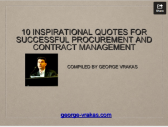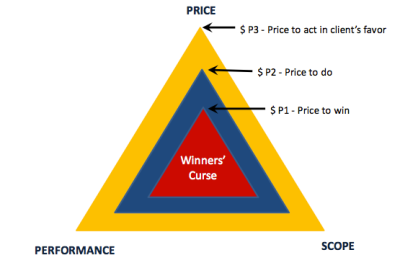10 Quotes for successful Procurement and Contract Management
February 27, 2014
Isaac Newton famously said “If I have seen further it is by standing on ye sholders of Giants”.
Procurement and Contract Management (P&CM) may not be as complicated as universal Physics but they equally can benefit from the wisdom of great thinkers.
A well crafted quote, very much like good storytelling, can elucidate fuzzy concepts.
There are many great quotes that seem to crystalise what best P&CM practices look like, however, some of them keep on coming up during our conversations.
Below is a selection of the ones I think are the most valuable in illuminating what good Procurement and Contract Management is.
1. “All models are wrong but some of them are useful” – George Box (Statistician)
I love this quote. There are times you hear about certain models or fads been promoted as panacea to everything. George Box reminds us that there is not one solution for all problems but that we need to take into account the exact requirements and specifications in its case and then, consider the best model to use so we can reach the optimum solution. You can read more about this here.
2. “‘People will forget what you said, people will forget what you did. But people will never forget how you made them feel”- Maya Angelou (Writer)
Emotional Intelligence is a key for successful P & CM as it is a key to successful negotiations (read more about negotiations here and here).
Because of the nature of our profession we sometimes find that P & CM professionals are task focused and/or mathematically inclined.
For those of us who fit this behavioural style, we just need to be aware and conscious of the limitations of our behavioural style and consciously pursue to fulfil the emotional aspect that is inherent to the P&CM interactions. Stakeholder Engagement and the building of Trust depends on it.
3. “We cannot solve our problems with the same thinking we used when we created them”- Albert Einstein
Creativity is a key component of successful P & CM. Our world is becoming more and more complex. The challenges our profession faces follow this trend. Unless we continuously challenge ourselves to think outside the box and to learn and embrace best practices, we face the possibility of been beaten by the competition.
Effectively, “You cannot solve today’s problems with yesterday’s thinking”.
4. “Opportunity arises for the prepared mind” -Louis Pasteur (chemist and microbiologist)
This quote goes hand in hand with Einstein’s quote above.
You should always keep an open mind so that you can identify opportunities as they arise. Do not presuppose that your solutions are the best. On the contrary, let your stakeholders express their ideas freely and assess them on merit.
Especially, for categories that are reliant on innovation, it is crucial to seek variant quotes and assess the responses with an open mind.
5. “A journey of a thousand miles begins with a single step” – Lao Tzu (Philosopher)
Nowadays, considering the optimum modus operandi for an P & CM team, there is a great deal of change to be done in most organisations. This is evident by the amount of organisations that are reported to engage in Procurement transformations. I predict that, in the near future, Contract Management transformations will also gain momentum.
Moreover, even if P&CM teams do achieve to perfect their modus operandi based on today’s standards and best practices, there will always be future opportunities for improvement. So, the journey is bound to start again.
As such, when you embark on a transformation journey, to consider at the same time all aspects that need to be transformed will be overwhelming.
So, pick one, change it and then proceed to the next. Not before long the accumulated benefits become substantial.
6 “Failing to prepare is, generally speaking, preparing very well to do the wrong thing”- Sam Harris (Neuroscientist)
There are a variety of situations in our profession where this quote holds true.
Successful P&CM heavily depends on successful stakeholder engagement and effective project management.
Focusing on preparation e.g. of the strategies, the alternatives and evaluating the desired outcomes means that the final result will not be random but the best possible.
7. “The beginning of wisdom is to define” – Aristotle (Philosopher)
It is evident that a great deal of the issues relating to disputes in negotiations and contracts is due to misunderstandings e.g. what the scope is, what the quality standards are etc.
It is thus, absolutely necessary that the Contracts, SLAs, RFPs etc contain definitions or glossaries.
As an example, take the common used term – SLA (Service Level Agreement). For some, this means the whole contract, for others it means only the KPIs. There are also interpretations that attribute the term SLA, not to the KPIs but, to the “Statement of Work, Scope and Definitions”, and so on.
8. “What gets measured, gets managed” – Peter Drucker
Think of a contract without KPIs and a similar one with well defined, tracked and acted upon KPIs. It is quite apparent that the latter has the better chances of working well.
It feels that the amount of attention a Customer pays to define the expectations and manage the contracts resembles the amount of attention the Supplier will invest in return.
So, taking the time to agree on the measurements and then act upon them means that, the quality remains a focus and the contract will be more easily managed.
9. “Simplicity is the ultimate sophistication” – Leonardo da Vinci
We have all come across contracts that are pestered with errors or are poorly written e.g. they contain long confusing sentences and overcomplicated verbose paragraphs.
Spending time on enhancing the clarity of the contract will ensure that there is no ambiguity for the Contract Manager to later follow up on.
Considering the amount of contracts and workload for P&CM nowadays means that it is essential to have contracts with simple style, form, ideally short in length, and with clear and lucid meanings. This will ensure that the contract will be understood, followed upon and eventually be a success.
Blaise Pascal made this point quite well. He, almost apologetically, wrote at the end of a very long letter.
‘Sorry for the length of my letter. If I had more time I would have written a shorter letter’. Blaise Pascal (paraphrasing from the original)
10. “One standard is worth a thousand committee meetings” – Dale Dauten
Nowadays, there are countless hours lost in meetings that reach no outcomes.
Forming a standard, e.g. a KPI or a process means that, there is clarity is what the benchmark is. Hence, people are focused and meetings have clear targets they need to arrive at. Having standards means that the ambiguity is removed and everyone is working towards the same well defined target.
These quotes are a selection from a wide variety of very useful thinking out there.
What are your favourite quotes that guide your behaviours at work?




